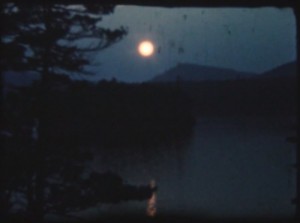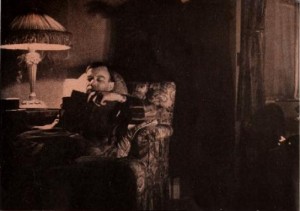
"Land of My Dreams, Joseph J. Harley, ACL, will tell you, is a simple record of fun and friends. As such, it is an attractive piece of Kodachrome, colorful in its camera work, leisurely in its pace (400 feet, 8mm.) and frankly sentimental in its outlook. Lake Saranac and the Harley summer cottage comprise the land of Joe Harley 's dreams, although his myriad friends of ten years' standing play a large part in that Elysium. You see them throughout the film, going about their fishing and boating, picnics and swimming with an infectious zest and good humor. The record is climaxed with a detailed presentation of a grand communal party, at which each of the guests is required to put on some sort of skit or bit of entertainment." Movie Makers, June 1944, 246.
Note of warning: the "communal party" referenced in the description above includes a performance in blackface.

"Among the ten best, The Last Entry, running seven reels 16mm., is one of the most ambitious amateur photoplays ever undertaken and completed. The plot, requiring many elaborate interior sets, is based on a mystery story that opens with a house party. While a room is darkened for the projection of amateur films, one of the guests is murdered and all present may be suspected equally. The detective handling the case uncovers the fact that the murdered man, an author, has lived on blackmail effected by threats of exposure through publication, which throws suspicion on several of the guests of the house party who were discovered to be his victims. However, in the end, the murder is solved by screening the same pictures that were on the projector when it was committed. Although this plot offered great difficulties in the direction of large group scenes, the creation of the necessary lighting effects and the interpretation of the actors' roles, it is beautifully and suavely handled. In the film are several lighting treatments that may be listed as among the most effective ever achieved by amateurs. One chase sequence staged through long corridors, a large, dimly lighted attic and on the roof of the mansion at night in the rain, can be likened only to the effects secured in the best professional mystery photoplays. James F. Bell, jr., ACL, was director with Charles H. Bell, ACL, and Benjamin Bull, jr., ACL, cameramen and Lyman Howe, ACL, in charge of lighting." Movie Makers, Dec. 1932, 537-538.
"Film documenting the joy Turner found while restoring his 1917 Henderson motorcycle which he describes in a letter to the original owner, Frank. Film also shows scenes of the Salt Lake Valley and shows Turner riding the bike in a parade." Church History Library.

"'Life,' by H. B. Hutchings, given the highest recognition for Home Movies, is the sort of picture that the 16mm camera was made for. It is a day in his son's life and contains many effects which were undoubtedly secured with one of the more modern cameras." American Cinematographer, Dec. 1933, 321, 342.
Life at Deep Cove "shows family leisure activities, 1937 Deep Cove Regatta; colour section of sunbathing and Deep Cove scenes" British Columbia Archives.

"This year, Ten Best welcomes a baby picture to its select circle. Out of the large number of personal and family films submitted to the League, Linda represents the ultimate in child movies. Here, in less than ten minutes of running time, unfold some of the high lights of the first few weeks of a baby's life. Following a carefully planned scenario, Richard Fuller shows himself well acquainted with motion picture technique. Lovely settings are accentuated by superb lighting. Pastel pinks and blues, colors intimately connected with the nursery, predominate. Fine cutting, well chosen camera viewpoints, effective use of dolly shots and double exposures all attest to a sound knowledge of cinematic expression. Above all, there is a feeling of quality and good taste. At the advent of a tiny stork, ingeniously controlled by wires, Mr. Fuller begins pacing the floor and lighting one cigarette after the other. Then, the routine of Linda's early days is set forth in charming fashion." Movie Makers, Dec. 1941, 564.
"A family picture built around the young daughter of Ira Radovsky. She is coming into the age when little girls want to go for a walk when things at home are not completely as they would like them. We follow the adventures of this young lady and enjoy every moment of it." PSA Journal, Nov. 1958, 46.
"Glen Turner might take a cue from "Gigi" and "Thank Heaven for little girls" with curly hair and their interesting mud pies. With teddy bear and dog, she does for a walk. En route we view the ducks, geese and other farm animals. The trees display their fall wardrobe to add to the delight of a walk in the woods. Soon the dog realizes they have gone too far from home and he goes back for Mother. Soon we return to the little girl asleep admidst the golden leaves. An enjoyable picture of things little girls like to do" PSA Journal, Nov. 1958, 46-47.
"Young girl plays house, cares for doll, irons doll clothes." oldfilm.org
"Film about the Woodley’s at their place in the country." Library and Archives Canada.
Total Pages: 19